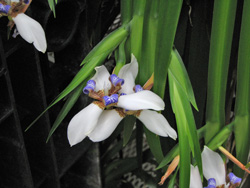Resource Library
Plant of the Week: Walking Iris
The University of Arkansas System Division of Agriculture does not promote, support or recommend plants featured in "Plant of the Week." Please consult your local Extension office for plants suitable for your region.
Plant of the Week
Walking Iris
Latin: Neomarica gracilis

Pass-along plants are a special group of plants that persist in our homes and gardens because they are tough, easily propagated and interesting enough to merit care. However, they lack the pizzazz necessary to make it in commerce, where they are bought and sold. Walking iris (Neomarica gracilis) is such a plant: Commonly seen, but you almost never see it in nurseries.
Neomarica is a Brazilian member of the iris family. It is clump-forming, with 24-inch long, pendulous, deep green and glossy sword-shaped leaves emerging from a group of congested rhizomes. Walking iris is sometimes called “apostle plant” because it was commonly supposed that the flower stalk emerged in the central position of a fan of 12 leaves; but in reality most rhizomes flower with six to eight leaves present.
In late winter and spring, the plant produces a 3-foot tall spike that bears a 3-inch diameter, light blue iris-like flower. The spike is enclosed in a sheath-like leaf, so it is flattened and resembles the leaves. The flowers are lightly fragrant and last only one day, but will continue to be produced every few days for a month or more.
Two species are commonly grown. N. gracilis, the more handsome of the two, has white outer petals marked with bands of brown or yellow at the base and bright blue, erect central petals. N. caerulea has blue or violet outer petals that usually are the same shade as the inner petals.
Walking iris is aptly named, for as the flower spike nears the end of its bloom cycle and continues to flop about, new plantlets begin to appear at the tip of the spike. In mild parts of the country, where the plant can be grown out of doors, this type of spread enlarges the colony faster than would occur from just the spread of the rhizomes. Indoors, these new plantlets are easily removed and rooted.
Michael Pollan in his book Botany of Desire (Random House, 2001) describes how the tulip-a piece of eye candy for gardeners for sure-rapidly spread around the world. He likens the beauty of the tulip as an evolutionary triumph, not for the amusement of gardeners, but as a biological means for tulips to perpetuate themselves. Neomarica and other pass-along plants use the same strategy, but they add an agreeable, easygoing and tough disposition to the mix. They’re just cute enough for people to hang on to them, and easy enough to propagate that they get dispersed throughout the world by non-conventional vectors: gardeners.
In zones 9 and south, walking iris can be grown outside in sunny or partially shaded beds. In colder regions it is grown in large containers and treated as a patio plant. Minimum pot size should be about 8 inches. They do best in more moist locations, often growing in the wild as a pond-edge plant. In containers they are not heavy feeders, and will persist for several years without repotting. Plantlets can be rooted by pegging the floppy stem into a new pot and keeping the soil moist until new roots form.
By: Gerald Klingaman, retired
Extension Horticulturist - Ornamentals
Extension News - January 29, 2010
The University of Arkansas System Division of Agriculture does not maintain lists of retail outlets where these plants can be purchased. Please check your local nursery or other retail outlets to ask about the availability of these plants for your growing area.